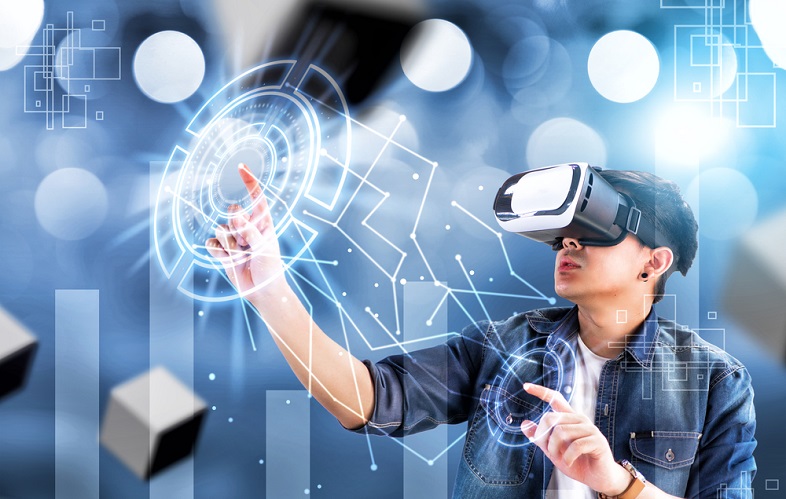Computer technology has already revamped how the entire world is run. It’s hard to imagine that what we’ve seen in the past three decades is simply the tip of the iceberg, but it’s true.
Researchers and programmers have barely scratched the surface of what artificial intelligence is capable of. Through fields like virtual reality (VR), the next ten years are set to be full of significant changes, too.
We might not have flying cars quite yet, but what’s in store is worthy of any “Jetsons” cartoon.
1. You Can Be in the Movies!
Millions of people dream of being movie stars, but only a few in a million make it to the big screen. Now, with VR technology in Real 3D, every time you head to the movie theater, you can be part of the action.
Real 3D technology uses a system that produces circularly polarized light. The result is a stereoscopic image projected on the screen. The projector has a special tool made from an electro-optical liquid crystal modulator.
This “Z Screen” is placed in front of the lens. The viewer wears glasses with polarized filters that change based on the action in the movie and the effects added by the director.
Put the glasses on, sit down, and relax. You’re about to be in a movie!
2. Doctors Will Learn and Operate With VR
People on the operating table in the past few years have already seen VR in the medical field. As more new doctors are trained in robotic surgery, it’s taking the place of physicians at the operating table.
VR is used to enhance the efficiency of diagnostic tools like CT scans and MRIs. With better images, doctors can evaluate complex issues and detect problems before they happen.
Got anxiety? Instead of treating patients with mental health issues with meds, some medical staff are prescribing VR.
The patient wears virtual reality headphones and gear that transport them to an imaginary peaceful world. The cortisol (stress hormone) in their body lowers, and when they come back to reality, they are better able to handle their problems.
3. VR in Stock Trading
The rise in penny stocks and smartphone apps has skyrocketed the stock trading industry. Innovations in augmented reality are set to take those numbers and multiply them.
VR can use audio and video enhancements to make the user feel like they’re in a simulated situation. Augmented reality (AR) does something similar. But it takes computer-generated images and brings them into the real world.
Think about any sci-fi movie you’ve seen where the star pulls up a virtual map and manipulates it. That’s AR.
Using VR and AR in trading means investors will see and interact with market data in a 3D environment, right in their own homes.
4. Healing Traumatic Brain Injuries With VR
Until recently, if a person had a traumatic brain injury (TBI), there wasn’t too much that could be done to treat them. Their symptoms could be alleviated through pain meds, but there was no actual way to help the patient.
Through VR technology, studies are showing the promising potential that this is changing.
When patients use VR technology in their rehab efforts, they are placed in a simulated environment. Since they “feel like” they’re in this new place emotionally and physically, their brains react as though they really are.
In short, the brain plasticity that was damaged gets stimulated, waking it up and strengthening those “muscles.”
Patients who have suffered a brain injury from strokes, for instance, can use VR rehab. It may help them recover their motor function and get back to daily living faster.
5. Your Can Can Drive You
In a truly Jetson-worthy advancement, autonomous cars have already hit the scene. But while the current technology is sporadic and rarely used, in the next decade, it will become the norm.
High-tech vehicles today already include some form of autonomy. The newest Lexus cars, for instance, have the option to let the car drive, control your direction, and alert you when your driving is less than perfect.
Human or Computer Error?
Understandably, people are concerned that “self-driving cars” will mean the person behind the wheel won’t pay attention. The worry is that without a human controlling the vehicle, computer error could cause an accident.
Yes, there have been some accidents in the testing of autonomous cars. However, the ratio of trips to collisions is much lower with VR and AR than with human drivers.
By the time the technology is perfected and the world operates on autonomous vehicles, there will be a slim margin of error. Compare that to distracted or inebriated human drivers, and you’ll quickly see the benefits of a self-driving car.
Conclusion
Virtual reality is coming for the world, whether you’re ready or not. You’ve already seen the advantages that computer technology has brought with it.
VR (and AR) are going to make tsunami-like waves in fields like healthcare and trading. Instead of drowning in the innovations, you can go with the flow if you start preparing now.

